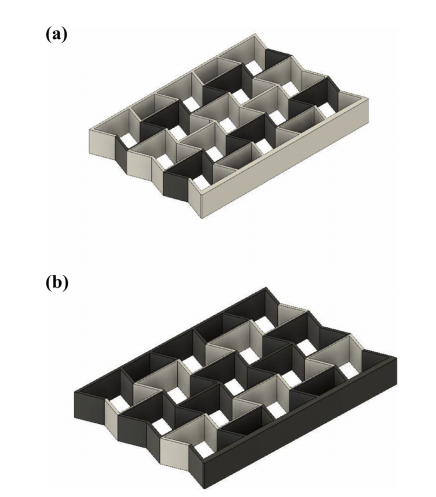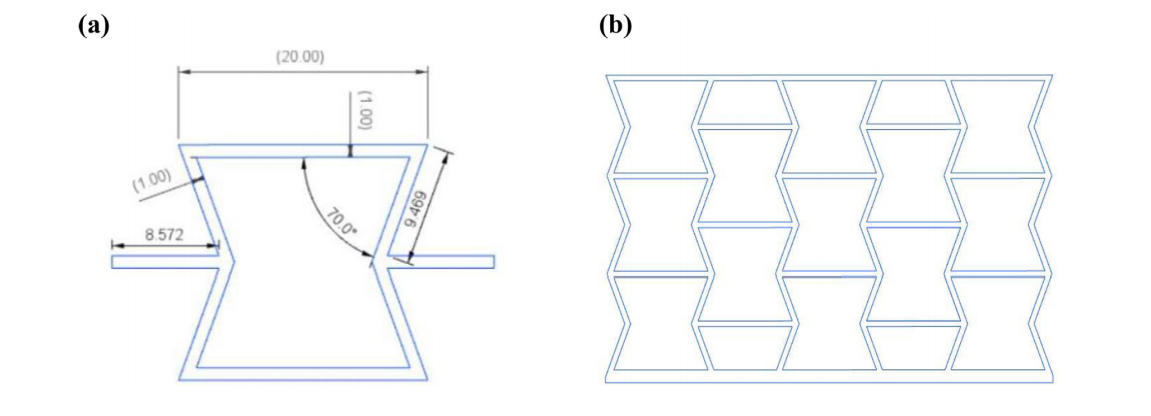International researchers are taking advantage of the next level beyond 3D printing to produce novel materials and structures, as outlined in the recently published ‘Reversible energy absorbing meta-sandwiches by FDM 4D printing.’
With a focus on reversible energy absorption applications, the authors fabricate ‘meta-sandwiches,’ developed from hyper-elastic polymers and elasto-plastic shape memory polymers.
Harkening to natural energy absorbers such as bones, teeth, hooves, and more, the scientists strive to create stable structures for use in cars and planes, make protective packaging, sports equipment, and more.
“The principle of energy absorption in meta-materials and lattice-based structures provides the capability to convert kinetic energy into other types of energies through elastic and/or plastic deformations, mechanical instability and structural collapse,” explain the authors.
In recent work, plastic deformation in metal and plastics has been the route for energy absorption, using alloys like nickel-titanium (NiTi), or combining amorphous polymers and flexible elastomers. With 3D printing, however, scientists have been able to experiment with metamaterials and lattice-based structures with success in energy absorption.
Auxetic meta-sandwiches are evidence of a conceptual design made up of soft hyper-elastic polymers and elasto-plastic hard SMPs, accentuated with cold programming—and ultimately, the authors expect to see these concepts offer new benefits in the design process of reversible energy dissipation devices.
As smart materials that can deform and then return to their initial shape, SMPs were used here at room temperature ‘lower than their glass transition temperature.’ The researchers then heated it above transition temperature range until it reverted to its normal state.
“The dissipated energy through the plastic deformation of SMPs, revealed as a hysteresis loop, is considered as the energy absorption mechanism in this work,” explain the researchers. “The SME is also considered to introduce recoverable energy absorbers.”
The researchers used a 3DGence Double P255 (with dual interchangeable hotends for dual-material printing) for 4D printing their sample lattice-based energy absorbers.
Evaluating the metastructures (both experimentally and numerically) showed that the designs offered the required non-linear stiffness and dissipating energy. Their experiments showed:
- Existence of the hysteresis loop
- Physics of snap-through instability
- Elasto-plasticity
“Comparison studies revealed that the main aspects of meta-sandwiches were well simulated in capturing yield stress, plateau during plastic deformation growth, unloading path and hysteresis area. It was also experimentally shown that the deformation and the dissipation processes are reversible opening an avenue for the design and implementation of recoverable energy dissipation devices for impact protection and shock mitigation applications,” concluded the researchers.
“Due to the absence of similar concept and results in the specialized literature, this paper is likely to advance the state-of-the-art 4D printing tunable metasandwiches with reversible energy absorption features.”

SMP meta-structure: (a)-(g) experimental and computational configuration, (h) force-displacement path for loading-unloading and thermal shape recovery (free strain recovery by thermal loading is represented by the red dash-dotted line), (i) dissipated and absorbed energies.
4D printing is one of the most exciting new areas to be inspired by 3D printing; and while it espouses much of the same technological processes, this is an area that seems even closer to magic, allowing for the use of exceptional metamaterials, magnetic actuators, composite materials, and more.
What do you think of this news? Let us know your thoughts! Join the discussion of this and other 3D printing topics at 3DPrintBoard.com.
[Source / Images: ‘Reversible energy absorbing meta-sandwiches by FDM 4D printing’]Subscribe to Our Email Newsletter
Stay up-to-date on all the latest news from the 3D printing industry and receive information and offers from third party vendors.
You May Also Like
Printing Money Episode 18: The DC Fly-In with Mark Burnham, AddMfgCoalition
It’s only been a week since the previous show, but Printing Money is back already with Episode 18. Certain events call for Printing Money’s coverage, and the recent 2nd Annual...
Aerospace OEM Invests $9.1M in Michigan for Metal 3D Printing and More
Barron Industries, a foundry based in Michigan specializing in serving the aerospace and defense sectors, has made a $9.1 million capital investment to expand its operations in Oxford, Michigan. The...
Can Higher Power Density Engines Lead to Broader 3D Printing Use?
Traditionally, when it comes to sports cars, interest has centered around metrics such as horsepower per cubic inch and power-to-weight ratios. These metrics are calculated and interpreted differently by various...
Wisconsin’s Evology Adds Digital Sheet Forming to Service Roster
Evology, a service bureau based in Wisconsin and specializing in serving strategic sectors like aerospace and defense, has added digital sheet forming (DSF) to its repertoire of manufacturing capabilities. Evology...



































